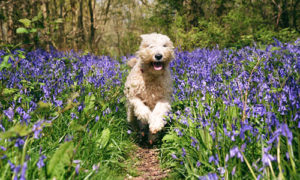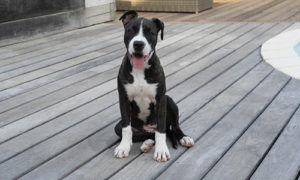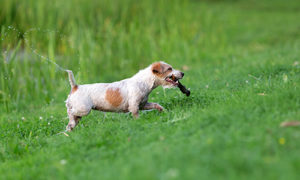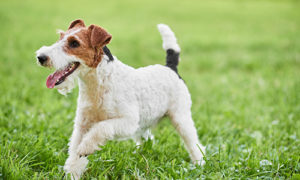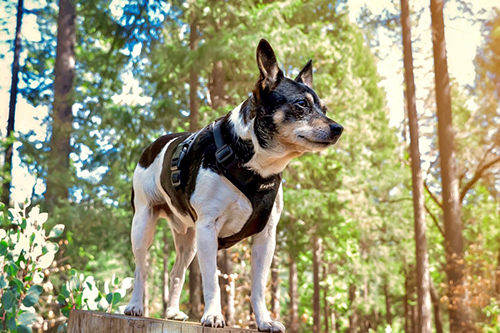
The ancestors of the Rat terrier likely included the Old English White Terriers, Bull Terriers, Smooth Fox Terriers, and Manchester Terriers. In the late 1800s, mixes of the breed were brought to America by Working class British Immigrants. The dogs were used for rat pit contests and vermin control. The rat pit contests consisted of men betting on how many rats the dog could kill within a certain amount of time.
The rat killing record is currently held by a Rat Terrier that killed 2,500 rats in seven hours inside a rat-infested barn. By the early 1900s, Rat Terriers were popular farm dogs and were probably among the most popular dogs in the United States.
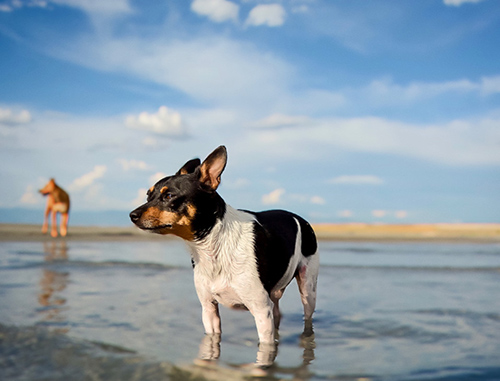
The Theodore Roosevelt Connection
Theodore Roosevelt was said to keep a few of the terriers in the White House. In fact, the Teddy Roosevelt Terrier is a short-legged version of the actual Rat Terrier. Midwestern farmers crossed their ratters with Italian Greyhounds and Whippets to increase the speed, allowing them to chase down and catch jackrabbits that were eating the crops in the early 1900s.
Rat Terriers were also crossed with beagles giving them greater scenting and pack driving abilities in the South. Traditionally, the dogs were not considered a breed; people thought them a strain, allowing them to cross to other breeds like today’s feist dogs, which are small terriers used to catch squirrels.
The Rat Terrier varies in size because they were used for hunting game that also varied in size. Unfortunately, the terrier’s popularity as a vermin hunter diminished with the advent of pesticides in the 1950s. However, the breed continued to persist thanks to their championship attributes. The UKC recognized the Rat Terrier in 1999, and the AKC recognized it in 2013.
Breed Standard
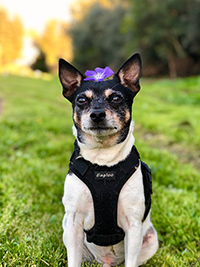
The Rat Terrier is an athletic and sturdy dog that is hard-muscled with rectangular proportions. You can find the breed in two sizes: miniature and standard. Both sizes are compact and well-balanced with a level, smooth back, a strong, arched neck; moderate bone; and oval-shaped feet. The tail is docked and carried slightly below or above the back, never over the back or curled.
The dog’s head is shaped like a smooth, blunt wedge, with a flat skull and muscular, smoothly tapered muzzle. It has wide-set, oval-shaped eyes and a keen, intelligent expression. The ears are shaped like a V and can be carried erect, semi-erect, tipped, or buttoned.
They are energetic and loyal companions and are always on a mission to find an adventure. The dog learns quickly and is eager to please but is not stubborn. However, they do get bored and distracted easily. Rat Terriers are scrappy dogs and will not back down from a challenge and will tangle with much larger dogs if threatened. The dogs can get along well with cats if raised together but keep them from pet rats. You’ve been warned. Also, most Rat Terriers are not considered to be excessive barkers.
Breed Facts
- Popularity: Uncommon
- Family Group: Terrier
- Country of Origin: United States
- Date Developed: 1800s
- Original Purpose: Ratting
- Current Function: Earthdog trials, companion
- Other Names: None
| Energy level | Watchdog ability | ||
| Exercise requirements | Protection ability | ||
| Playfulness | Grooming requirements | ||
| Affection level | Cold tolerance | ||
| Friendliness toward dogs | Heat tolerance | ||
| Friendliness toward other pets | Friendliness toward strangers | ||
| Ease of training |
Activity Level
Moderate. These terriers are little athletic dogs that require daily activity in the form of interactive play, running or long walks. Keep in mind that the dogs will chase perceived prey if given an opportunity and should always be exercised on a leash. They are powerful jumpers; therefore, your fence should be five to six feet tall. The breed also needs mental exercises, which you can meet by playing indoor games and tricks on stormy days. They are well-behaved and quiet house dogs if provided proper exercise and mental stimulation.
Group: Terrier
AKC Recognition: 2013
Grooming
The Rat Terrier should be brushed at least twice weekly using a grooming glove or a soft brush to keep shedding under control. Also, because the coat is so thin and the dogs are so small, they are susceptible to chilling.
Coat: Close, short, shiny, and smooth
Color: Most often black, white with large patches of one or more colors, chocolate, apricot, red, lemon, blue, or fawn.
Rat Terrier Temperament
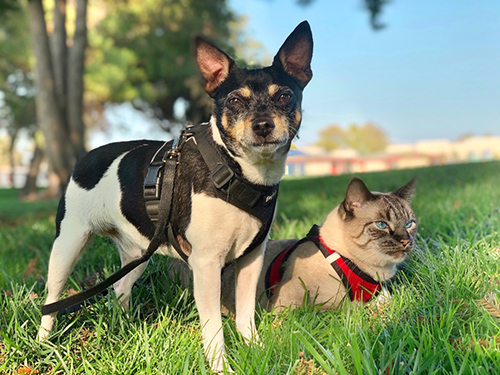
The parent club describes the breed as intelligent, plain fun, athletic, and loyal. These dogs are also referred to as a full-blooded Yankee Doodle breed. They are highly observant of their environment, vigilant, and quick to react. These traits make for a very playful dog, and they usually stay active throughout their lives. However, they may not be trustworthy around other animals. The Rat Terrier also shares ancestry with hounds, making it more pack-oriented.
The dogs are affectionate and notably loyal to their owners and usually friendly toward other dogs. They are sensitive and highly responsive to training and are easy to housetrain. They may be submissive or reserved with strangers. The breed can be territorial and protective of their families, which they consider part of the pack. Rat Terrier puppies should be introduced to obedience training and ongoing socialization at an early age to ensure a balanced temperament.
Health
- Major Health Concerns: none
- Minor Health Issues: allergies, patellar luxation
- Rarely Seen: none
- Recommended Tests: Knee
- Life Span: 12 to 15 years
- Weight: 8 to 25 pounds
- Height: miniature – 10 to 13 inches; standard – 13 to 18 inches
Breeder and Buyer’s Advice
Before locating Rat Terriers for sale, make sure you learn as much as you can about the breed. Find a trusted breeder through the parent club, and make sure to ask plenty of questions before you purchase. Potential owners should also consider adopting or acquiring a rescued Rat Terrier.
Parent Club
Rat Terrier Club of America; founded in 1993
Rescue: The RTCA lists breed rescue information on the parent club’s website.
Frequently Asked Questions
Do Rat Terriers make good pets?
Do Rat Terriers like to be held?

